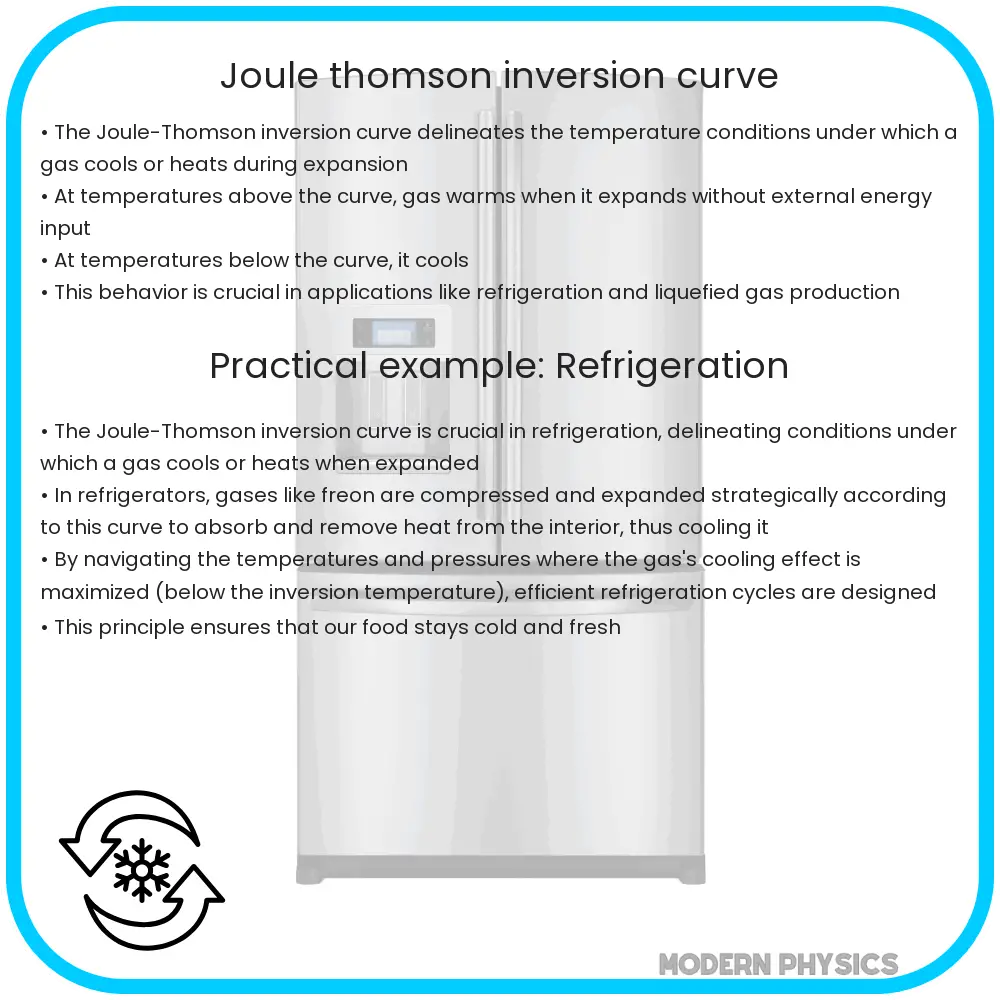Explore the Joule-Thomson Effect and Inversion Curve Dynamics in gases, their applications in industry, and the factors influencing temperature changes.

Understanding the Joule-Thomson Effect and Inversion Curve Dynamics
The Joule-Thomson Effect, a fundamental concept in thermodynamics, describes the temperature change of a gas or liquid when it is forced through a valve or porous plug while being insulated so that no heat is exchanged with the environment. This phenomenon is crucial in applications ranging from refrigeration to the behavior of natural gas in pipelines.
Basics of the Joule-Thomson Effect
At the core of the Joule-Thomson Effect is the principle that when a gas expands, its temperature changes. This is due to the relationship between pressure, volume, and temperature in gases. As a gas expands, its pressure drops, and if no external work is done, its internal energy changes leading to a temperature change.
Inversion Curve and Its Significance
The Inversion Curve plays a critical role in understanding this effect. It is a graph that shows the temperatures at which a gas’s temperature will either increase or decrease under the Joule-Thomson Effect. On one side of this curve, the gas cools upon expansion (below the inversion temperature), while on the other, it heats up (above the inversion temperature).
Real Gases vs. Ideal Gases
It’s important to note that the Joule-Thomson Effect is only observable in real gases. Ideal gases, which are hypothetical gases that follow the ideal gas law (PV = nRT, where P is pressure, V is volume, n is the amount of substance, R is the ideal gas constant, and T is temperature), do not experience this effect because their internal energy is solely a function of temperature, not volume or pressure.
Applications of the Joule-Thomson Effect
This effect is exploited in various practical applications, especially in refrigeration and air conditioning systems. The cooling effect observed in these systems is a direct result of the Joule-Thomson Effect, making it a cornerstone of modern thermal management technologies.
Understanding the dynamics of the Joule-Thomson Effect and the inversion curve is essential for engineers and scientists dealing with gas behaviors in various industrial and environmental contexts.
Detailed Dynamics of the Inversion Curve
The inversion curve’s dynamics are intricate and vary significantly depending on the type of gas. For most gases, the inversion temperature increases with pressure. This means that at higher pressures, a greater temperature change can be achieved. This principle is particularly relevant in high-pressure applications such as gas liquefaction and cryogenic engineering.
Factors Affecting the Joule-Thomson Effect
Several factors influence the magnitude and direction of the temperature change in the Joule-Thomson Effect. These include the specific type of gas, its initial temperature and pressure, and the degree of expansion. Different gases have different inversion temperatures, which are key to determining their behavior under the Joule-Thomson Effect. For instance, hydrogen and helium have very high inversion temperatures, making them heat up when expanded at room temperature.
Mathematical Representation
The Joule-Thomson coefficient (\(\mu_{JT}\)) quantitatively describes the effect. It is defined as the change in temperature per unit change in pressure at constant enthalpy. The coefficient can be positive or negative, depending on whether the gas cools or heats up. Mathematically, it is expressed as \(\mu_{JT} = \left(\frac{\partial T}{\partial P}\right)_H\), where \(T\) is temperature, \(P\) is pressure, and \(H\) stands for constant enthalpy.
Practical Implications in Industry
In industrial settings, the Joule-Thomson Effect is harnessed for controlled temperature regulation. In the natural gas industry, for example, the effect is used to lower the temperature of gas in pipelines, thereby preventing potential hazards due to high temperatures and ensuring efficient transport. Similarly, in the field of cryogenics, the effect is employed to achieve extremely low temperatures required for various applications, including medical and scientific research.
Conclusion
The Joule-Thomson Effect, with its associated inversion curve dynamics, is a pivotal concept in thermodynamics, playing a vital role in a wide array of industrial and scientific applications. Understanding this phenomenon is not just academically intriguing but also essential for practical applications in refrigeration, natural gas processing, and cryogenics. The effect underscores the intricate relationship between temperature, pressure, and volume in real gases, offering a window into the complex behavior of gases under varying conditions. As technology advances, the principles of the Joule-Thomson Effect continue to find new applications, further cementing its importance in the realms of science and engineering.
